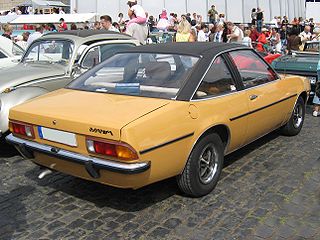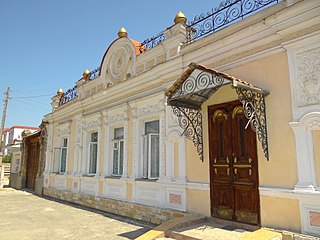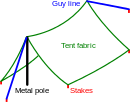
Canvas is an extremely durable plain-woven fabric used for making sails, tents, marquees, backpacks, shelters, as a support for oil painting and for other items for which sturdiness is required, as well as in such fashion objects as handbags, electronic device cases, and shoes. It is popularly used by artists as a painting surface, typically stretched across a wooden frame.
Needlepoint is a type of canvas work, a form of embroidery in which yarn is stitched through a stiff open weave canvas. Traditionally needlepoint designs completely cover the canvas. Although needlepoint may be worked in a variety of stitches, many needlepoint designs use only a simple tent stitch and rely upon color changes in the yarn to construct the pattern. Needlepoint is the oldest form of canvas work.

A tent is a shelter consisting of sheets of fabric or other material draped over, attached to a frame of poles or a supporting rope. While smaller tents may be free-standing or attached to the ground, large tents are usually anchored using guy ropes tied to stakes or tent pegs. First used as portable homes by nomads, tents are now more often used for recreational camping and as temporary shelters.

Panties or knickers are a form of underwear worn by women. Panties can be form-fitting or loose. Typical components include an elastic waistband, a crotch panel to cover the genitalia, and a pair of leg openings that, like the waistband, are often made of elastomer. Various materials are used, but are usually chosen to be breathable.

A yurt or ger (Mongolian) is a portable, round tent covered and insulated with skins or felt and traditionally used as a dwelling by several distinct nomadic groups in the steppes and mountains of Inner Asia. The structure consists of a flexible angled assembly or latticework of wood or bamboo for walls, a door frame, ribs, and a wheel possibly steam-bent as a roof. The roof structure is sometimes self-supporting, but large yurts may have interior posts supporting the crown. The top of the wall of self-supporting yurts is prevented from spreading by means of a tension band which opposes the force of the roof ribs. Yurts take between 30 minutes and 3 hours to set up or take down, and are generally used by between five and 15 people. Nomadic farming with yurts as housing has been the primary life style in Central Asia, particularly Mongolia, for thousands of years.

A pillow is a support of the body at rest for comfort, therapy, or decoration. Pillows are used in different variations by many species, including humans. Some types of pillows include throw pillows, body pillows, decorative pillows, and many more. Pillows that aid sleeping are a form of bedding that supports the head and neck. Other types of pillows are designed to support the body when lying down or sitting. There are also pillows that consider human body shape for increased comfort during sleep. Decorative pillows used on beds, couches or chairs are sometimes referred to as cushions.

Vinyl roof refers to a vinyl covering for an automobile's top.

A shelter-half is a simple kind of partial tent designed to provide temporary shelter and concealment when combined with one or more sections. Two sheets of canvas or a similar material are fastened together with snaps, straps or buttons to form a larger surface. The shelter-half is then erected using poles, ropes, pegs, and whatever tools are on hand, forming an inverted V structure. Small tents like these are often called pup tents in American English.

A windbreaker, or a windcheater, is a thin fabric jacket designed to resist wind chill and light rain, making it a lighter version of the jacket. It is usually of lightweight construction and characteristically made of a synthetic material. A windbreaker often uses elastic waistbands, and/or armbands, and a zipper to allow adjustments for the current weather conditions.

A tonneau is an area of a car, truck, or boat open at the top. It can be for passengers or cargo. When applied to trucks it refers to their bed or tray.

An awning or overhang is a secondary covering attached to the exterior wall of a building. It is typically composed of canvas woven of acrylic, cotton or polyester yarn, or vinyl laminated to polyester fabric that is stretched tightly over a light structure of aluminium, iron or steel, possibly wood or transparent material. The configuration of this structure is something of a truss, space frame or planar frame. Awnings are also often constructed of aluminium understructure with aluminium sheeting. These aluminium awnings are often used when a fabric awning is not a practical application where snow load as well as wind loads may be a factor.

A canopy is an overhead roof or else a structure over which a fabric or metal covering is attached, able to provide shade or shelter from weather conditions such as sun, hail, snow and rain. A canopy can also be a tent, generally without a floor. The word comes from the ancient Greek κωνώπειον, from κώνωψ, which is a bahuvrihi compound meaning "mosquito". The first 'o' changing into 'a' may be due to influence from the place name Canopus, Egypt thought of as a place of luxuries.
Marine canvas refers to a varied array of fabrics used in the fabrication and production of awnings, covers, tarps, sunshades, signs and banners for the advertising, boating, trucking, tenting, structural and medical industries. The term "marine canvas" is also used more narrowly to refer specially to boat cover products.

A bell tent is a human shelter for inhabiting, traveling or leisure that has been used since 600AD. The design is a simple structure, supported by a single central pole, covered with cotton canvas. The stability of the tent is reinforced with tension by guy ropes connected around the top of the walls and being held down by pegs around the circumference to the ground. It has a circular floor plan of some 10 ft and larger.
The multiple sizes of bell tents can be suited to their use or preference and most have a spacious interior, with room to sleep a number of people.

"Technical textile" refers to a category of textiles specifically engineered and manufactured to serve functional purposes beyond traditional apparel and home furnishing applications. These textiles are designed with specific performance characteristics and properties, making them suitable for various industrial, medical, automotive, aerospace, and other technical applications. Unlike conventional textiles used for clothing or decoration, technical textiles are optimized to offer qualities such as strength, durability, flame resistance, chemical resistance, moisture management, and other specialized functionalities to meet the specific needs of diverse industries and sectors.

A roof tent or rooftop tent is an accessory that may be fitted to the roof or bed of a motor vehicle that allows the users to sleep in relative safety and comfort above the vehicle, and leaves the internal load-space free. The first example of roof tents appeared in Western Europe in the 1930s.

The architecture of Mongolia is largely based on traditional dwellings, such as the yurt and the tent. During the 16th and 17th centuries, lamaseries were built throughout the country as temples which were later enlarged to accommodate a growing number of worshipers. Mongolian architects designed their temples with six and twelve angles and pyramidal roofs approximating the yurt's round shape. Further expansion led to a quadratic shape in the design of the temples, with roofs in the shape of pole marquees. Trellis walls, roof poles and layers of felt were eventually replaced by stone, brick beams and planks.

A loue is an ultra-light Finnish open tent-like shelter. It is used to give reasonable protection from wind and rain during a variety of outdoor activities, including camping, canoeing, hiking and hunting. Loues are popular with Scout groups and minimalist campers. Suitable as one or two person shelters, they are compact, light and can be set up and taken down in a basic way fairly quickly. The workman-like sets shown in photographs indicate that more effort can be made to stiffen the sides and the stakes and lines used can complicate a taut setup. The open front permits fire viewing, ventilation and looking out over a scenic view. A loue consists of a roughly conical section of fabric with the semi-circular bottom edge grounded by stakes and the tip raised with a single pole. Suitable standing tree trunks may be used to suspend the tent if an open campfire is not to be used. This style of ''tarp tent" can best be raised using a scissors-pole assembly. A pole suspension system allows for positioning an open fire in front of the shelter without the risk of damaging tree trunks or roots. The panels of a true Finnish loue are designed to provide a semi-circular short wall around the shelter and a triangular piece at the tip can be let down to provide a little more shelter in front. With suitable siting and careful staking and tensioning, the side walls can be set close to the ground, providing protection from drafts and lifting from winds.
A fabric structure is a structure made of fabric, with or without a structural frame made from the weaving of the fabric itself. The technology provides end users a variety of aesthetic free-form building designs. Custom-made structures are engineered and fabricated to meet worldwide structural, flame retardant, weather-resistant, and natural force requirements. Fabric structures are considered a sub-category of tensile structure.

Architextiles refers to a broad range of projects and approaches that combine architecture, textiles, and materials science. Architextiles explore textile-based approaches and inspirations for creating structures, spaces, surfaces, and textures. Architextiles contribute to the creation of adaptable, interactive, and process-oriented spaces. Awning is the most basic type of architectural textile. In Roman times, a velarium was used as an awning to cover the entire cavea, the seating area within amphitheaters, serving as a protection for the spectators against the sun.



















